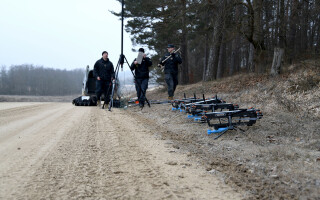Military Embedded Systems
Op-Eds
Cyber
Embedded systems, meet the Internet of Things - Blog
August 20, 2015Comms
Ensure authenticity by eliminating counterfeit parts - Blog
August 12, 2015Unmanned
Looking toward 7th and 8th generation warfare - Blog
July 07, 2015Avionics
Going modular? Meet data and control coupling - Blog
June 10, 2015Radar/EW
Security value of processor-driven configuration for FPGA-SoCs - Blog
June 01, 2015Intel to buy FPGA maker Altera for more than $16 billion - Blog
June 01, 2015Last Unmanned Systems show roundup - Blog
May 14, 2015Comms
The fascinating world of containers - and why the military should care - Blog
May 14, 2015Radar/EW
Sixth generation warfare: manipulating space and time - Blog
May 12, 2015Navy veteran Mariana Iriarte joins Mil-Embedded editorial staff - Blog
April 07, 2015Comms
Powering devices using Ethernet - Blog
April 03, 2015Radar/EW
Inspiring electronic warfare careers in Canada - Blog
March 09, 2015Unmanned
Unmanned
Defense electronics get boost from in-house manufacturing - Blog
March 03, 2015-
Training and simulation systems to support Saab GlobalEye under new CAE agreement
November 21, 2025
-
Next-gen pilot training system to be developed by Saab, Boeing, and BAE Systems
November 19, 2025
-
KC-390 refueling capability validated with Gripen E in Brazilian test campaign
November 17, 2025
-
F-35 air combat training subsystems to be delivered by Cubic
November 13, 2025
-
Terma acquires OSL Technology to boost counter-UAS, infrastructure protection offerings
November 27, 2025
-
EDA project to reduce noise from autonomous underwater vehicles
November 25, 2025
-
Littelfuse Expands X4-Class Portfolio with 200 V, 480 A Ultra-Junction MOSFET in SMPD-X Package
November 25, 2025
-
Uncrewed systems pact for Baltics signed between Quantum Systems and ADV Defense
November 25, 2025
Cyber
-
DoD awards Hewlett Packard Enterprise a 10-year contract for cloud computing upgrades
December 01, 2025
-
PRODUCT OF THE WEEK: Atek DataKey Mini-Bar Crypto Ignition Key series
November 10, 2025
-
Network and cyber support contract signed between Sev1Tech and Navy command
October 15, 2025
-
Firefly Aerospace to acquire SciTec, Inc.
October 06, 2025
-
Beyond GNSS/GPS: magnetic navigation and multisensor resilience in contested skies
December 04, 2025
-
Power under pressure: Meeting the military’s surging energy demands
December 04, 2025
-
Shield AI, Sedaro partner to build software to support on-orbit operations
December 04, 2025
-
Hydra MAX SATCOM terminal reaches TRL 6 in U.S. Army testing
November 26, 2025








